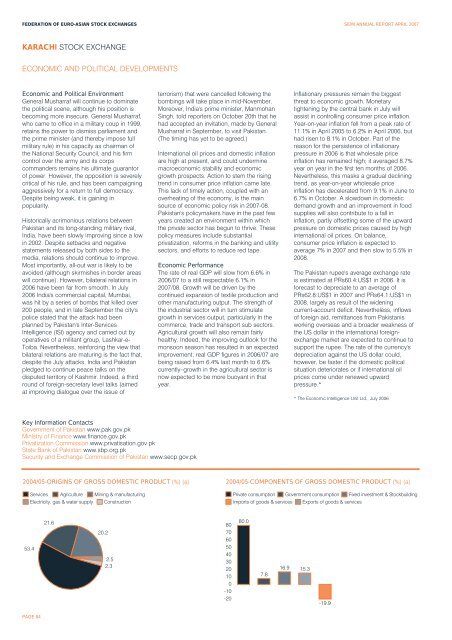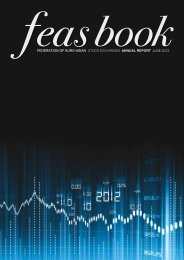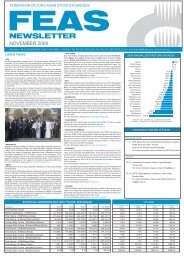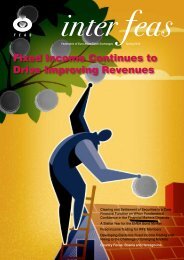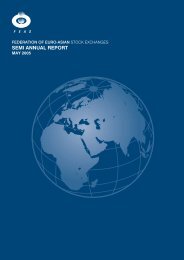Download - FEAS
Download - FEAS
Download - FEAS
Create successful ePaper yourself
Turn your PDF publications into a flip-book with our unique Google optimized e-Paper software.
FEDERATION OF EURO-ASIAN STOCK EXCHANGES SEMI ANNUAL REPORT APRIL 2007<br />
KARACHI STOCK EXCHANGE<br />
ECONOMIC AND POLITICAL DEVELOPMENTS<br />
Economic and Political Environment<br />
General Musharraf will continue to dominate<br />
the political scene, although his position is<br />
becoming more insecure. General Musharraf,<br />
who came to office in a military coup in 1999,<br />
retains the power to dismiss parliament and<br />
the prime minister (and thereby impose full<br />
military rule) in his capacity as chairman of<br />
the National Security Council, and his firm<br />
control over the army and its corps<br />
commanders remains his ultimate guarantor<br />
of power. However, the opposition is severely<br />
critical of his rule, and has been campaigning<br />
aggressively for a return to full democracy.<br />
Despite being weak, it is gaining in<br />
popularity.<br />
Historically acrimonious relations between<br />
Pakistan and its long-standing military rival,<br />
India, have been slowly improving since a low<br />
in 2002. Despite setbacks and negative<br />
statements released by both sides to the<br />
media, relations should continue to improve.<br />
Most importantly, all-out war is likely to be<br />
avoided (although skirmishes in border areas<br />
will continue). However, bilateral relations in<br />
2006 have been far from smooth. In July<br />
2006 India's commercial capital, Mumbai,<br />
was hit by a series of bombs that killed over<br />
200 people, and in late September the city's<br />
police stated that the attack had been<br />
planned by Pakistan's Inter-Services<br />
Intelligence (ISI) agency and carried out by<br />
operatives of a militant group, Lashkar-e-<br />
Toiba. Nevertheless, reinforcing the view that<br />
bilateral relations are maturing is the fact that,<br />
despite the July attacks, India and Pakistan<br />
pledged to continue peace talks on the<br />
disputed territory of Kashmir. Indeed, a third<br />
round of foreign-secretary level talks (aimed<br />
at improving dialogue over the issue of<br />
terrorism) that were cancelled following the<br />
bombings will take place in mid-November.<br />
Moreover, India's prime minister, Manmohan<br />
Singh, told reporters on October 20th that he<br />
had accepted an invitation, made by General<br />
Musharraf in September, to visit Pakistan.<br />
(The timing has yet to be agreed.)<br />
International oil prices and domestic inflation<br />
are high at present, and could undermine<br />
macroeconomic stability and economic<br />
growth prospects. Action to stem the rising<br />
trend in consumer price inflation came late.<br />
This lack of timely action, coupled with an<br />
overheating of the economy, is the main<br />
source of economic policy risk in 2007-08.<br />
Pakistan's policymakers have in the past few<br />
years created an environment within which<br />
the private sector has begun to thrive. These<br />
policy measures include substantial<br />
privatization, reforms in the banking and utility<br />
sectors, and efforts to reduce red tape.<br />
Economic Performance<br />
The rate of real GDP will slow from 6.6% in<br />
2006/07 to a still respectable 6.1% in<br />
2007/08. Growth will be driven by the<br />
continued expansion of textile production and<br />
other manufacturing output. The strength of<br />
the industrial sector will in turn stimulate<br />
growth in services output, particularly in the<br />
commerce, trade and transport sub sectors.<br />
Agricultural growth will also remain fairly<br />
healthy. Indeed, the improving outlook for the<br />
monsoon season has resulted in an expected<br />
improvement; real GDP figures in 2006/07 are<br />
being raised from 6.4% last month to 6.6%<br />
currently–growth in the agricultural sector is<br />
now expected to be more buoyant in that<br />
year.<br />
Inflationary pressures remain the biggest<br />
threat to economic growth. Monetary<br />
tightening by the central bank in July will<br />
assist in controlling consumer price inflation.<br />
Year-on-year inflation fell from a peak rate of<br />
11.1% in April 2005 to 6.2% in April 2006, but<br />
had risen to 8.1% in October. Part of the<br />
reason for the persistence of inflationary<br />
pressure in 2006 is that wholesale price<br />
inflation has remained high; it averaged 8.7%<br />
year on year in the first ten months of 2006.<br />
Nevertheless, this masks a gradual declining<br />
trend, as year-on-year wholesale price<br />
inflation has decelerated from 9.1% in June to<br />
6.7% in October. A slowdown in domestic<br />
demand growth and an improvement in food<br />
supplies will also contribute to a fall in<br />
inflation, partly offsetting some of the upward<br />
pressure on domestic prices caused by high<br />
international oil prices. On balance,<br />
consumer price inflation is expected to<br />
average 7% in 2007 and then slow to 5.5% in<br />
2008.<br />
The Pakistan rupee's average exchange rate<br />
is estimated at PRs60.4:US$1 in 2006. It is<br />
forecast to depreciate to an average of<br />
PRs62.8:US$1 in 2007 and PRs64.1:US$1 in<br />
2008, largely as result of the widening<br />
current-account deficit. Nevertheless, inflows<br />
of foreign aid, remittances from Pakistanis<br />
working overseas and a broader weakness of<br />
the US dollar in the international foreignexchange<br />
market are expected to continue to<br />
support the rupee. The rate of the currency's<br />
depreciation against the US dollar could,<br />
however, be faster if the domestic political<br />
situation deteriorates or if international oil<br />
prices come under renewed upward<br />
pressure.*<br />
* The Economic Intelligence Unit Ltd., July 2006<br />
Key Information Contacts<br />
Government of Pakistan www.pak.gov.pk<br />
Ministry of Finance www.finance.gov.pk<br />
Privatization Commission www.privatisation.gov.pk<br />
State Bank of Pakistan www.sbp.org.pk<br />
Security and Exchange Commission of Pakistan www.secp.gov.pk<br />
2004/05-ORIGINS OF GROSS DOMESTIC PRODUCT (%) (a)<br />
Services Agriculture Mining & manufacturing<br />
Electricity, gas & water supply Construction<br />
2004/05-COMPONENTS OF GROSS DOMESTIC PRODUCT (%) (a)<br />
Private consumption Government consumption Fixed investment & Stockbuilding<br />
Imports of goods & services Exports of goods & services<br />
53.4<br />
21.6<br />
20.2<br />
2.5<br />
2.3<br />
80<br />
70<br />
60<br />
50<br />
40<br />
30<br />
20<br />
10<br />
0<br />
-10<br />
-20<br />
80.0<br />
7.8<br />
16.9 15.3<br />
-19.9<br />
PAGE 84


